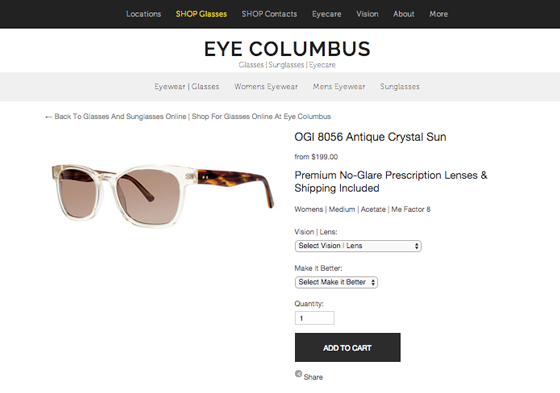
The Eye Columbus homepage greets users with three simple sections:
“SHOP Glasses | Sunglasses,” “The Lifestyle Eye Exam” and “Request an Appointment.”
Last year, Vision Monday took an in depth look at how traditional eyecare practitioners and frame dispensers were adapting to the eyewear e-commerce trend (
“E-Commerce Exposed: ECPs Speak Up on Experiences Selling Online.”) As predicted, many independent optical retailers are continuing to experiment with different e-store solutions.

Craig Miller, OD,
owner of Eye Columbus.
One such practitioner is Craig Miller, OD, owner of
Eye Columbus in Columbus, Ohio, who recently elected to transform his practice website into an e-commerce platform. Serving as an educational, attractive space for patients to “preview” his two brick-and-mortar locations, the site is intended not only for shopping, but for learning about eyecare and the practice’s product selection in-store. Miller told CLICK about his platform of choice and why any ECP should consider its services.
Eye Columbus is located in a “retail-driven market,” according to Miller, with employees of Abercrombie and Fitch, Limited and other retail chains making up a large portion of his client base. He pointed out that patients and consumers today do everything online, from completing their paperwork to making appointments, so showcasing his store’s product selection—though not cataloguing everything—is another way to get peoples’ attention.
“We decided in May to go completely e-comm and quit messing around. That’s what consumers look for nowadays—it’s just the accepted method of shopping. It’s not because we wanted to sell a ton of glasses online. We have to present ourselves in the same manner as the big retail players,” he said.
At first, Miller, who has been in practice for 10 years and owner of Eye Columbus’ two locations for four years, toyed with the idea of hosting an e-store as a separate entity and essentially, separate business from Eye Columbus.
“I first thought about having a totally different website for e-commerce because I was wondering how receptive other people—especially non patients—would be to buying their contacts online from a local eye doctor. The perception that local eye doctors are more expensive [than larger online eyewear e-tailers] is not the case. I realized that it doesn’t matter who it is, as long as the website is well designed, well built and user friendly. If you have the right product and it’s packaged cleanly and it’s easy, it doesn’t matter if you’re a local doctor or a big corporation with hundreds of people working on the website. As long as you can get people connected, it will be more beneficial to have people in one platform.”
Miller first tried creating an e-commerce site for Eye Columbus with
Shopify, a website building company known for its storefront-focused templates and built-in functionality for online retail. While Shopify’s optimization for selling and tracking products online proved useful for e-tail, Miller said, he found the platform limiting for optical professionals.
“I was building on Shopify for 3 months…it was a little more limited for our world. When a consumer for [optical] makes a purchase, there are so many more variables than the small, medium and large,” he said, using the sizing selection for a T-shirt sale as an example.

The streamlined site allows for easy purchases and often showcases independent brands.
For eyewear, finding the right platform to support specific measurements and determining how the site would translate over time was the next challenge. Miller turned to
Squarespace, a content-centric website building platform that has e-commerce capabilities. Since he did not plan on using the site primarily for product sales, he found this option a better fit for Eye Columbus.
“Squarespace gave us more options. I don’t want to say it’s a perfect solution—there is still a lot of work involved—but it’s simple enough for those who have some experience in web design,” he said. “You don’t have to do any coding, it’s a point and click kind of site.” For Eye Columbus, the transition was easy.
“We have a creative team in house, so we made the decision to be focused on the internet at an early time. It allowed us to move things forward a lot faster. For us, it was a very simple, efficient task. It all depends on how comfortable someone is with managing the technology and how creative someone is—if they’re not, there are plenty of people who are,” he said, referring to web designers who can be hired for the service.
As is the case for many optical retailers who incorporate e-stores into their websites, contact lenses have shown the most success in terms of sales, Miller said. However, sales on the site are not the point—presentation is.
“Contact lens sales are incredible online,” he said, noting that many contact lens customers are not initially patients at Eye Columbus. “We are selling glasses online, but I think what [our customers use it for] is an online catalogue to our store.”
The practice also puts their own spin on things by providing patient education in the e-comm environment. “It’s important for us to really know what we’re educating our patients on, not just saying, ‘here are some frames,’ or ‘here are some great lenses’—but showing companies that are doing great things for independent optometry.”
Eye Columbus drives it all home by directing traffic to the site through social media channels like Twitter, for conversational purposes, and Instagram and Pinterest for image-driven engagement, Miller said. In any platform, Eye Columbus keeps its focus on the consumer, not the product.
“We do a lot of social media but we try to stay focused on 40 to 50 percent consumer based products, things people want to see, even if it’s not a product we’re selling. Fun pictures, inspirational and educations things, a lot of newsy and community chatting…We don’t hit up too much directly to our product page,” he said. “Even though it’s an e-commerce site, there’s still tons of information. It all ties in well.”
For more information on Shopify, Squarespace and other small business digital resources, visit “Squarespace Vs. Shopify for Ecommerce” on
intentionallydigital.com.